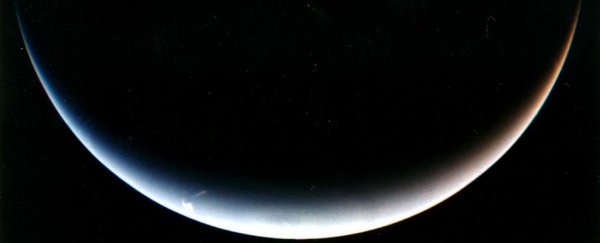Scientists have discovered a mysterious object located on the outskirts of the Solar System, and while we don't know much about it yet, what we do know doesn't make a whole lot of sense.
Nicknamed Niku, it appears to be a trans-Neptunian object, which means it's a minor planet that exists past Neptune. But that's where things start to get a little strange.
While there are lots of minor planets that we know about – ie. objects smaller than planets that aren't comets – and scientists are finding more all the time, Niku doesn't behave like the rest of them.
For starters, Niku orbits the Sun on a plane that's tilted 110 degrees to the plane of the Solar System – the flat orbital disk in which the planets move around the Sun. It's currently above the plane and rising higher, but it will eventually start lowering as it orbits back around.
Weirder still, while nearly all the objects in our Solar System orbit the Sun in the same direction – called the prograde direction – Niku bucks the trend, with a retrograde (or backwards) orbit of the Sun.
It's not the first time a trans-Neptunian object has been discovered with a retrograde orbit, but when you combine it with Niku's orbital tilt, it becomes clear that there's something very unusual about this minor planet.
"It suggests that there's more going on in the outer Solar System than we're fully aware of," astrophysicist Matthew Holman from the Harvard-Smithsonian Centre for Astrophysics explained to Shannon Hall at New Scientist.
Holman was part of an international team of scientists that discovered Niku, using the Panoramic Survey Telescope and Rapid Response System (Pan-STARRS) in Maui, Hawaii.
The extreme faintness of the object – it's 160,000 times fainter than Neptune – suggests Niku is relatively small, perhaps less than 200 kilometres in diameter.
But what really perplexes the researchers is what set Niku in its bizarre orbit – against the flow of pretty much everything else in the Solar System, and at a crazy angle to boot.
"Angular momentum forces everything to have that one spin direction all the same way," astronomer Michele Bannister from Queens University Belfast in the UK, who wasn't involved in the find, told New Scientist. "It's the same thing with a spinning top, every particle is spinning the same direction."
So for Niku to break with this, scientists think the object must have come into collision with something else, or was pulled off course by another gravitational source. But right now, nobody knows what this other object or group of objects could be.
It's possible that Niku is part of a group of objects all moving with an unusual alignment to the plane of the Solar System.
If such a grouping sounds familiar, that could be because it was this kind of gathering of unusually aligned objects in the Kuiper belt that gave rise to the Planet Nine hypothesis – the suspected (but unconfirmed) massive planet on the fringes of the Solar System that orbits the Sun once every 10,000 to 20,000 years.
Holman and the Niku team examined whether Niku's unusual movements could be attributed to the existence of Planet Nine – or perhaps a dwarf planet in the vicinity – but the minor planet is too close to the centre of the Solar System, so there's still no explanation as yet.
"We don't know the answer," admits Holman.
It's worth pointing out that the team's study has yet to be peer-reviewed, but it's available on arXiv.org while the researchers take feedback prior to publication. Until that time, or until we know more, some are taking the Niku findings with a grain of salt.
"As they say in the paper, what they have right now is a hint," Konstantin Batygin, one of the researchers who suggested the existence of Planet Nine, told New Scientist. "If this hint develops into a complete story that would be fantastic."
But that doesn't mean we can't get a little excited about this crazy planetary anomaly. As Bannister tweeted when she heard the news: "I hope everyone has buckled their seatbelts because the outer Solar System just got a lot weirder."
